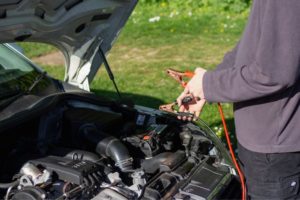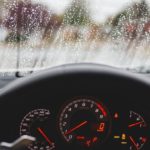Quick Navigation
You could often ask yourself why do I hear water in my car battery?

If so, it could be a sign that there is water in your car battery, which can cause serious damage if it is not addressed.
So, what should you do about it? Let’s take a look!
1. Why Is There Water in My Car Battery?
Inside a car battery are two metal plates called “lead plates”.
These plates are submerged in an electrolyte solution composed of water and sulfuric acid in the form of a paste.
The lead plates create a chemical reaction that produces electrical energy when connected to an external circuit.
This chemical reaction requires liquid to work properly. Without it, the battery wouldn’t be able to produce any charge.
For this reason, your car must have enough water in its battery for it to function properly.
So if you hear water in your battery, don’t worry. It’s not even pure water!
Most modern batteries come pre-filled and sealed with water, a far cry from the days of having to fill up each battery with water manually.
Before, you had to open up the caps every few months to check the electrolyte levels and refill as required.
Nowadays, however, it’s much more straightforward – purchase a new one when needed!
Still, if you have a standard lead-acid battery. In that case, it is essential to check the level of the electrolyte solution regularly and top it up with distilled water if needed.
If your battery runs low on water or gets overfilled, it can cause a number of issues ranging from reduced performance to damage to the battery itself.
2. What Should I Do If There Is Water in My Car Battery?
If you notice that there is water in your car battery, it is important to take immediate action to avoid damage to your vehicle’s electrical system.
To do this, you must follow these steps:
2.1 Safety First!
Before you commence any work, be sure to shut off your vehicle and draw the key from its ignition.
Then, pinpoint both your battery’s positive and negative terminals before detaching them.
You can do it with a wrench or pliers to avoid any electrical current running through it as you fix it up.
2.2 Remove any Excess Water
To rid the battery of any water, gently tilt it to allow liquid to exit through the cells. To soak up surplus moisture, employ a towel or rag.
If excessive water is in the battery, utilize a syringe or turkey baster for removal.
2.3 Clean the Battery
Scrub away corrosion and residue from the battery terminals with a wire brush or sandpaper to ensure optimal contact when you plug in your battery.
Cleaning the area surrounding these components is also essential for smooth operation.
2.4 Refill the Cells
To ensure your battery is working at its best, it’s essential to check the water level in its cells. If you notice that it’s running low, fill them with distilled water only.
You can damage the battery with tap water as it contains minerals that can harm it. Take care not to overfill and stop just underneath the fill line for optimal performance.
2.5 Reconnect the Battery
Connect the battery again. Securely fasten the positive and negative terminals of the battery to ensure a safe connection.

2.6 Check for Damage
Examine the battery and its surrounding area carefully for any signs of damage. If you spot cracks or leaks in the casing, it’s time to get a new one.
Don’t wait – safety should always be your top priority!
2.7 Test the Battery
The final step is to test the battery. After finishing all the steps above, turn on your car’s ignition to see if it runs smoothly.
If not, you may need to replace the battery as it’s often times cheaper than hiring a professional to repair it.
Make sure that if you notice water in your car battery, it may suggest a leak or overcharging issue.
If this situation continues, the wisest course of action is to contact either an expert technician or the manufacturer for assistance.
Ultimately, if you detect water in your car battery, it’s crucial to act fast and protect the vehicle’s electrical system from harm.
First, drain the water from the battery. Then clean off its terminals and the surrounding area, as oxidation can also damage your battery.
See if there are any changes to cell levels of liquid and reattach the battery again. After you have finished, inspect it for damage and give it a test run.
Though these steps should be enough to solve this type of issue – if not – consulting with an expert or producer is advisable.
What Should I Do If I Reach the Correct Electrolyte Levels?
After the correct electrolyte levels have been reached, use a damp cloth to clean the terminals and posts of any accumulated deposits over time.
This should help prevent further corrosion and restore the battery’s full power output.
Once everything is clean and dry, you can reattach the negative terminal before returning the battery to your vehicle.
At this point, it’s also important to check for any electrical system issues in order to verify that no further damage was done as a result of having water in your car battery.
In some cases, even after all these steps are taken, certain components may need to be replaced.
Suppose you need help with how to proceed with any part of the process.
In that case, it’s best to consult a professional who can help guide you through each step and provide more information on maintaining your battery’s longevity.
Properly caring for your car battery can save you time and money down the road.
How Can I Prevent Too Much Water Accumulating In My Car Battery?
The best way to prevent too much water from accumulating in your car battery is to ensure it has enough venting.
If you have a sealed, maintenance-free battery, ensure that the cells are properly sealed and filled with acid. Check its levels regularly and top up if needed.
Check the electrolyte level monthly for older traditional batteries and add distilled water as needed.
In addition, ensure that any corrosive gases created during the charging process can escape easily by keeping the vents on your battery clean and clear of obstructions.
Finally, use an appropriate voltage charger for your battery – never overcharge or undercharge it, as this can cause damage or lead to excessive accumulation of water inside the battery.
You can keep your car battery working safely and efficiently with regular care and attention.
Remember, if your battery is more than three years old, it may be time to replace it with a new one.
Keeping on top of maintenance can extend the life of your battery and help you avoid costly repairs or replacements in the future.

How to Fix a Flooded Battery?
If your car battery has been flooded, you’ll need to act quickly to prevent further damage.
First, disconnect the positive terminal from the negative and remove it from the vehicle completely.
Then, clean the terminals of any debris or corrosion with a damp cloth and baking soda solution. Rinse off any residue using water.
Next, refill each cell with distilled water until it reaches just below the bottom of its filler neck (check your owner’s manual for exact measurements).
If there is extensive corrosion on your battery terminals, you may need to replace them before reconnecting.
Charge your battery fully to get it up and running again safely and efficiently. Once charged, reconnect the positive terminal first and then the negative.
Finally, test your battery to ensure it’s working correctly before returning it to its place in the car.
By following these steps, you should be able to successfully fix a flooded battery and get back on the road again safely.
Conclusion
Keeping tabs on your car battery’s health is essential for ensuring its longevity and performance over time.
As a general rule of thumb, make sure to check all cells for proper levels of liquids at least once every two months.
This way, you can spot any potential issues early before they become serious problems down the line.
If you ever notice any signs of corrosion or reduced cranking power, be sure to test your car battery and clean the connections.
If you still experience issues, then you may have to buy a new battery.

Kevin has been hanging around cars and automobile magazines since he knew what a car is. He grew up in his father’s 1995 Mercedes E320 Wagon and Volkwagon Phaeton W12 2004. He rides his first car, a manual 1979 Porche 911SC.
Currently, he owns an Acura Integra GS-R. During his childhood, he showed a keen interest in how things actually work and fix them. This passion transforms into his eternal love for cars and bestows him an ideal position in one of the leading automobile companies; whenever he finds time, he takes out his Acura and opts for the longest possible route to find hidden wholesome pleasure in a road trip.
Want to read some of the articles written by Kevin? Head to our blog section to find out all the articles written by Kevin.







